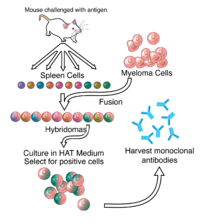
Photo from wikipedia
Introduction: In clinical trials of patients treated with pembrolizumab, RECIST-defined progressive disease (PD) is often assumed to reflect generalized lack or loss of efficacy. However, mixed lesion-level responses within a… Click to show full abstract
Introduction: In clinical trials of patients treated with pembrolizumab, RECIST-defined progressive disease (PD) is often assumed to reflect generalized lack or loss of efficacy. However, mixed lesion-level responses within a given patient may reflect more clinically and immunobiologically-relevant heterogeneity than has been previously appreciated. To examine the heterogeneity and clinical impact of progressive disease, we characterized the patient-level and lesion-level responses in 511 patients with melanoma treated with pembrolizumab. Methods: Of 655 patients with melanoma treated with pembrolizumab in KEYNOTE-001 (NCT01295827), 511 patients had at least two scans and qualified for analysis. Patients were categorized as primary progression (RECIST-defined PD at first scan) or secondary progression (RECIST-defined PD as second scan or beyond). The percent change in diameter of overall and individual target lesions were examined, as well as patterns and timing of progression in non-target and new lesions. Results: Of 511 patients, 308 (60%) developed progression at some point during the study (primary progression 211/308, 69%; secondary progression 97/308, 31%). Of patients with primary progression, 105 (50%) had increased tumor burden (>20% sum growth), while 90 (43%) had stable tumor burden (-30-+20% sum change) and 16 (8%) had decreased tumor burden (>-30% sum decrease). Lesion-level heterogeneity was substantial, with 167 (79%) of patients having at least one shrinking metastasis despite primary progression. In patients with secondary progression, timing of onset was variable (median 56 weeks, +/- 35 weeks). Only 15% of patients with acquired resistance, (5% of patients with PD), displayed rebound of all lesions. The remaining patients displayed rebound of a subset of lesions (38%) and/or appearance of new metastatic lesions (46%). Lesion-level responses that have been achieved often persisted at/after onset of secondary progression. Conclusions: Patterns of progression to pembrolizumab are heterogeneous. In primary progression, there is evidence of some lesion-level benefit in the majority of patients. In secondary progression, many lesions demonstrate continued benefit despite isolated/oligo sites of progression. Consideration of these patterns may inform optimal treatment strategies. Lesion-specific analysis of biomarkers may be necessary to improve correlative analyses and response prediction. Citation Format: Brian Topp, Rukmini Kumar, Kapil Mayawala, Dinesh de Alwis, Matt D. Hellmann, Alexandra Snyder. Inter-tumoral heterogeneity of progressive disease in melanoma patients treated with pembrolizumab [abstract]. In: Proceedings of the AACR Virtual Special Conference on Tumor Heterogeneity: From Single Cells to Clinical Impact; 2020 Sep 17-18. Philadelphia (PA): AACR; Cancer Res 2020;80(21 Suppl):Abstract nr PO-131.
Journal Title: Cancer Research
Year Published: 2020
Link to full text (if available)
Share on Social Media: Sign Up to like & get
recommendations!